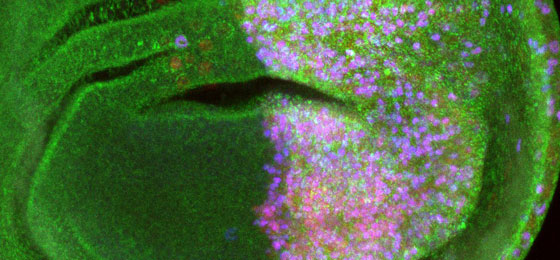Divide and rule: a tumour's strategy

SNSF-study about the earliest stage of tumour development opens up new ways of attacking cancer at its root.
When normal body cells escape the control from their peers, a tumour can form and eventually lead to cancer. Scientists have been struggling to understand how exactly these cells manage to set themselves free in the first place.
The team of Eduardo Moreno, professor at the Institute of Cell Biology at the University of Bern, has now discovered that a mechanism that is known from the early development of embryos plays a role in the earliest stages of adult tumour development (*).
As part of their SNSF-funded project, the researchers were able to film the cells of developing fruit fly pupas under the microscope for several hours. The genetically modified fruit flies carried an artificially activated gene called Myc, which is known to be involved in tumour formation.
The gene alone was sufficient to induce abnormal cells to divide more actively, squeeze through between healthy cells, kill them and take over their place. This represents an unexpected mechanism of invading tissues in the first phase of tumour development.
A model for most cancers
“The activation of the tumour gene gave the cells special mechanical properties helping them to intermingle with normal cells, surround them and eventually kill them more efficiently”, says Romain Levayer, the first author of the study.
“This invasion mechanism is known to be active during embryonic development when cells rearrange themselves to transform the body shape. We have now shown that cells are capable of using the same programme in order to invade healthy tissue”, says group leader Moreno. “Divide and rule”, the famous military strategy, is how the researchers describe the aggressive cells' behaviour.
The mechanism could explain the earliest beginnings of tumour development of most cancer types and is different from invasion mechanisms of metastases in later phases. “We were able to observe the mechanism in fruit fly pupas. The fruit fly was chosen as a model because it can be easily modified genetically. Since the pupa does not move and is transparent, it is ideal for observation under the microscope”, says Moreno.
About 90 percent of all cancers form in lining tissues (epithelia) like the one filmed in the pupas: in colon, skin or the mammary gland. The manipulated Myc gene is the most commonly misregulated gene in tumours. The identified mechanism could therefore apply to many cancers and help scientists to find new strategies to prevent tumour formation at its root before much damage has been caused.
(*) R. Levayer, B. Hauert and E. Moreno et al. (2015). Myc-induced cell mixing is required for competitive tissue invasion and destruction. Nature online: doi:10.1038/nature14684
(Available to journalists as a PDF file from the SNSF: com@snf.ch)
> Video of Invasion Mechanism (on YouTube): https://youtu.be/DaQ4oXPTHK0
Abnormal green cells invade healthy purple tissue in fruit fly pupa
© Eduardo Moreno, University of Bern
Contact
Prof. Dr. Eduardo Moreno
Institute of Cell Biology
Baltzerstrasse 4
CH-3012 Bern
Phone: +41 (0)31 631 46 77
E-mail: eduardo.moreno@izb.unibe.ch
http://www.snf.ch/en/researchinFocus/media/press-releases/Pages/default.aspx
Media Contact
All latest news from the category: Life Sciences and Chemistry
Articles and reports from the Life Sciences and chemistry area deal with applied and basic research into modern biology, chemistry and human medicine.
Valuable information can be found on a range of life sciences fields including bacteriology, biochemistry, bionics, bioinformatics, biophysics, biotechnology, genetics, geobotany, human biology, marine biology, microbiology, molecular biology, cellular biology, zoology, bioinorganic chemistry, microchemistry and environmental chemistry.
Newest articles

First-of-its-kind study uses remote sensing to monitor plastic debris in rivers and lakes
Remote sensing creates a cost-effective solution to monitoring plastic pollution. A first-of-its-kind study from researchers at the University of Minnesota Twin Cities shows how remote sensing can help monitor and…

Laser-based artificial neuron mimics nerve cell functions at lightning speed
With a processing speed a billion times faster than nature, chip-based laser neuron could help advance AI tasks such as pattern recognition and sequence prediction. Researchers have developed a laser-based…

Optimising the processing of plastic waste
Just one look in the yellow bin reveals a colourful jumble of different types of plastic. However, the purer and more uniform plastic waste is, the easier it is to…



